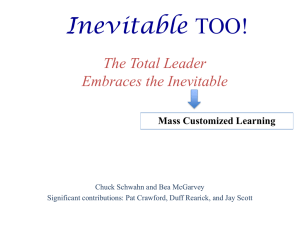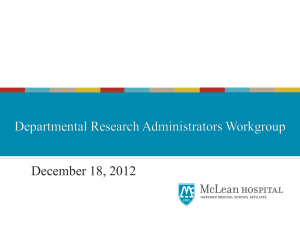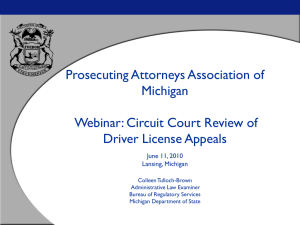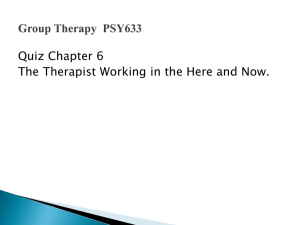Perioperative Quality Assurance - UM Anesthesiology
advertisement
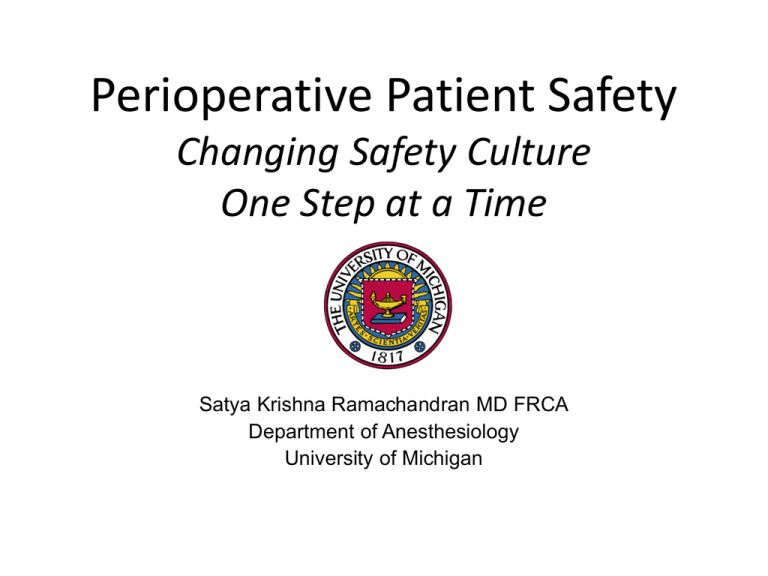
Perioperative Patient Safety Changing Safety Culture One Step at a Time Satya Krishna Ramachandran MD FRCA Department of Anesthesiology University of Michigan Disclosures • Paid scientific advisory consultant – Galleon Pharmaceuticals – Merck, Sharp & Dohme • Funding – PSA with MSD for 2014 – MiCHR CTSA PGP UL1TR000433 for 2014 The material of this talk is independent of these disclosures This is a confidential Quality Improvement and Assurance/peer review document of the University of Michigan Hospitals and Health Centers. Unauthorized disclosure or duplication is absolutely prohibited. This document is protected from disclosure pursuant to the provisions of MCL 333.20175; MCL 333.21515; MCL 331.531; MCL 331.533 or such other statutes that may be applicable How Hazardous Is HealthCare? PATIENT SAFETY AND HUMAN FACTORS TO ERR IS HUMAN We can't solve problems by using the same kind of thinking we used when we created them Albert Einstein Where Healthcare Was • Cottage Industry Mentality • Virtually Total Reliance on: – Professional/Individual Responsibility – Individual Perfection – Train and Blame • Little Understanding of Systems Relative to People and Processes – Ignorance vs. Arrogance This is a confidential Quality Improvement and Assurance/peer review document of the University of Michigan Hospitals and Health Centers. Unauthorized disclosure or duplication is absolutely prohibited. This document is protected from disclosure pursuant to the provisions of MCL 333.20175; MCL 333.21515; MCL 331.531; MCL 331.533 or such other statutes that may be applicable Where Healthcare Is • Cottage Industry Mentality • Virtually Total Reliance on: – Professional/Individual Responsibility – Individual Perfection – Train and Blame • Little Understanding of Systems Relative to People and Processes – Ignorance vs. Arrogance This is a confidential Quality Improvement and Assurance/peer review document of the University of Michigan Hospitals and Health Centers. Unauthorized disclosure or duplication is absolutely prohibited. This document is protected from disclosure pursuant to the provisions of MCL 333.20175; MCL 333.21515; MCL 331.531; MCL 331.533 or such other statutes that may be applicable Patient Safety Culture A culture of safety can be defined as an integrated pattern of individual and organizational behaviour based upon shared beliefs and values that continuously seeks to minimize patient harm that may result from the processes of care delivery (Kizer, 1999) This is a confidential Quality Improvement and Assurance/peer review document of the University of Michigan Hospitals and Health Centers. Unauthorized disclosure or duplication is absolutely prohibited. This document is protected from disclosure pursuant to the provisions of MCL 333.20175; MCL 333.21515; MCL 331.531; MCL 331.533 or such other statutes that may be applicable Importance of Culture • “Health care organizations must develop a culture of safety such that an organization's care processes and workforce are focused on improving the reliability and safety of care for patients.” (p. 14; IOM, 1999) • “The biggest challenge to moving toward a safer health system is changing the culture from one of blaming individuals for errors to one in which errors are treated not as personal failures, but as opportunities to improve the system and prevent harm.” (p. 79; Crossing the Quality Chasm, 2001) This is a confidential Quality Improvement and Assurance/peer review document of the University of Michigan Hospitals and Health Centers. Unauthorized disclosure or duplication is absolutely prohibited. This document is protected from disclosure pursuant to the provisions of MCL 333.20175; MCL 333.21515; MCL 331.531; MCL 331.533 or such other statutes that may be applicable Culture and Patient Safety Patient Safety Culture Norms and Behaviour Enabler/ Barrier Patient Safety Patient Safety Interventions Typical Approach • New Policies, Regulations, Reporting Systems, Training • Good First Step But….. – Lack of Systems Insight – Superficial Solutions (?Answers) – Inadequate Follow-Up – Lost Opportunity This is a confidential Quality Improvement and Assurance/peer review document of the University of Michigan Hospitals and Health Centers. Unauthorized disclosure or duplication is absolutely prohibited. This document is protected from disclosure pursuant to the provisions of MCL 333.20175; MCL 333.21515; MCL 331.531; MCL 331.533 or such other statutes that may be applicable Typical Missing Features • • • • • • Clear Understanding of Goal Preventive Approach Field Understanding & Buy-In Systems Approach Sustainability Trust/Culture of Safety This is a confidential Quality Improvement and Assurance/peer review document of the University of Michigan Hospitals and Health Centers. Unauthorized disclosure or duplication is absolutely prohibited. This document is protected from disclosure pursuant to the provisions of MCL 333.20175; MCL 333.21515; MCL 331.531; MCL 331.533 or such other statutes that may be applicable Patient Safety Culture Elements • • • • • Leadership commitment to safety Organizational resources for patient safety Priority of safety versus production Effectiveness and openness of communication Openness about problems and errors – Near misses • Organizational learning (Singer et al. 2003) This is a confidential Quality Improvement and Assurance/peer review document of the University of Michigan Hospitals and Health Centers. Unauthorized disclosure or duplication is absolutely prohibited. This document is protected from disclosure pursuant to the provisions of MCL 333.20175; MCL 333.21515; MCL 331.531; MCL 331.533 or such other statutes that may be applicable IOM Strategy For Improvement • Education: Establishing a national focus to create leadership, research, tools, and protocols to enhance the knowledge base about safety • Reporting: Identifying and learning from errors by developing a nationwide public mandatory reporting system and by encouraging health care organizations and practitioners to develop and participate in voluntary reporting systems This is a confidential Quality Improvement and Assurance/peer review document of the University of Michigan Hospitals and Health Centers. Unauthorized disclosure or duplication is absolutely prohibited. This document is protected from disclosure pursuant to the provisions of MCL 333.20175; MCL 333.21515; MCL 331.531; MCL 331.533 or such other statutes that may be applicable IOM Strategy For Improvement • Implementing safety systems in health care organizations to ensure safe practices at the delivery level • Professionalism: Raising performance standards and expectations for improvements in safety through the actions of oversight organizations, professional groups, and group purchasers of health care This is a confidential Quality Improvement and Assurance/peer review document of the University of Michigan Hospitals and Health Centers. Unauthorized disclosure or duplication is absolutely prohibited. This document is protected from disclosure pursuant to the provisions of MCL 333.20175; MCL 333.21515; MCL 331.531; MCL 331.533 or such other statutes that may be applicable CHANGING CULTURE RESIDENT EDUCATION Key points • Patient Safety, Professionalism and Quality Improvement skills are extremely valuable for all career paths • These attributes have renewed emphasis in the NAS – Anesthesiologists are uniquely positioned to lead – We can leverage existing resources to improve teaching/learning of these attributes – The goal is to create physicians who are in tune with growing public demand for accountability and transparency, while upholding the highest standards of clinical care This is a confidential Quality Improvement and Assurance/peer review document of the University of Michigan Hospitals and Health Centers. Unauthorized disclosure or duplication is absolutely prohibited. This document is protected from disclosure pursuant to the provisions of MCL 333.20175; MCL 333.21515; MCL 331.531; MCL 331.533 or such other statutes that may be applicable Why change the system? The ACGME’s public stakeholders have heightened expectations of physicians – team-oriented care – information-technology literacy – sensitivity to cost-effectiveness – the ability to involve patients in their own care, and – the use of health information technology to improve care for individuals and populations This is a confidential Quality Improvement and Assurance/peer review document of the University of Michigan Hospitals and Health Centers. Unauthorized disclosure or duplication is absolutely prohibited. This document is protected from disclosure pursuant to the provisions of MCL 333.20175; MCL 333.21515; MCL 331.531; MCL 331.533 or such other statutes that may be applicable CLER This is a confidential Quality Improvement and Assurance/peer review document of the University of Michigan Hospitals and Health Centers. Unauthorized disclosure or duplication is absolutely prohibited. This document is protected from disclosure pursuant to the provisions of MCL 333.20175; MCL 333.21515; MCL 331.531; MCL 331.533 or such other statutes that may be applicable CLER - QA Areas of Focus 1. Patient Safety – opportunities for residents to: – report errors, unsafe conditions & near misses – participate in inter-professional teams to promote & enhance safe care. 2. Quality Improvement – engage residents in using data to: – improve systems of care, – reduce health care disparities & – improve patient outcomes. 3. Professionalism – educate for professionalism, – monitor behavior on the part of residents and faculty & – respond to issues concerning: (i) accurate reporting of program information; (ii) integrity in fulfilling educational and professional responsibilities; & (iii) veracity in scholarly pursuits. So How Can You Make a Difference? • Problem: No Problem This is a confidential Quality Improvement and Assurance/peer review document of the University of Michigan Hospitals and Health Centers. Unauthorized disclosure or duplication is absolutely prohibited. This document is protected from disclosure pursuant to the provisions of MCL 333.20175; MCL 333.21515; MCL 331.531; MCL 331.533 or such other statutes that may be applicable Non-Punitive Systems Approach • TIVA for acoustic neuroma • Patient coughs = surgeon very upset – In a punitive system – event would go unreported • Root cause contributing factors: – Carrier fluid ran out (without alerting resident) – Antibiotics hung on carrier line – Teaching session ongoing distracting clinical care – Depth of anesthesia unknown – Isoflurane could be used (AEP) This is a confidential Quality Improvement and Assurance/peer review document of the University of Michigan Hospitals and Health Centers. Unauthorized disclosure or duplication is absolutely prohibited. This document is protected from disclosure pursuant to the provisions of MCL 333.20175; MCL 333.21515; MCL 331.531; MCL 331.533 or such other statutes that may be applicable CHANGING CULTURE REPORTING ADVERSE EVENTS Patient Safety • How to report a clinical event? – hint: search for “QA” in Centricity This is a confidential Quality Improvement and Assurance/peer review document of the University of Michigan Hospitals and Health Centers. Unauthorized disclosure or duplication is absolutely prohibited. This document is protected from disclosure pursuant to the provisions of MCL 333.20175; MCL 333.21515; MCL 331.531; MCL 331.533 or such other statutes that may be applicable Patient Safety • How to report a confidential QA concern? – hint: search for “QA” in Centricity This is a confidential Quality Improvement and Assurance/peer review document of the University of Michigan Hospitals and Health Centers. Unauthorized disclosure or duplication is absolutely prohibited. This document is protected from disclosure pursuant to the provisions of MCL 333.20175; MCL 333.21515; MCL 331.531; MCL 331.533 or such other statutes that may be applicable Patient Safety • What happens when you report an event? An anesthesia reviewer (usually faculty member) from the QA Committee conducts a comprehensive incident review… This is a confidential Quality Improvement and Assurance/peer review document of the University of Michigan Hospitals and Health Centers. Unauthorized disclosure or duplication is absolutely prohibited. This document is protected from disclosure pursuant to the provisions of MCL 333.20175; MCL 333.21515; MCL 331.531; MCL 331.533 or such other statutes that may be applicable Standard Review Process This is a confidential Quality Improvement and Assurance/peer review document of the University of Michigan Hospitals and Health Centers. Unauthorized disclosure or duplication is absolutely prohibited. This document is protected from disclosure pursuant to the provisions of MCL 333.20175; MCL 333.21515; MCL 331.531; MCL 331.533 or such other statutes that may be applicable Patient Safety • How to identify system issues from adverse event reports? SYSTEM FACTORS Equipment failure Technical accident Communication error Limitation of therapeutic standards Limitation of diagnostic standards Limitation of available resources This is a confidential Quality Improvement and Assurance/peer review document of the University of Michigan Hospitals and Health Centers. Unauthorized disclosure or duplication is absolutely prohibited. This document is protected from disclosure pursuant to of thesupervision provisions of MCL 333.20175; Limitation MCL 333.21515; MCL 331.531; MCL 331.533 or such other statutes that may be applicable This is a confidential Quality Improvement and Assurance/peer review document of the University of Michigan Hospitals and Health Centers. Unauthorized disclosure or duplication is absolutely prohibited. This document is protected from disclosure pursuant to the provisions of MCL 333.20175; MCL 333.21515; MCL 331.531; MCL 331.533 or such other statutes that may be applicable The Postoperative Patient Care Handover UH PACU This is a confidential Quality Improvement and Assurance/peer review document of the University of Michigan Hospitals and Health Centers. Unauthorized disclosure or duplication is absolutely prohibited. This document is protected from disclosure pursuant to the provisions of MCL 333.20175; of Anesthesiology, University Michigan Health System MCL Department 333.21515; MCL 331.531; MCL 331.533 or suchofother statutes that may be applicable The Postoperative Patient Care Handover a plan for improvement UMHS Proposal: 1. Clearly establish & communicate patient care handover expectations to all involved care givers. 2. Standardize handoff communication by: developing a comprehensive, succinct conversation guideline for all handovers leveraging the EHR to provide easily accessible and retrievable electronic documentation 3. Establish expectations for the required Timing of and Participants in the care handover 4. Provide a clearly communicated path for care This is a confidential Qualityescalation Improvement and Assurance/peer review document of the University of Michigan Hospitals and Health Centers. Unauthorized disclosure or duplication is absolutely prohibited. This document is protected from disclosure pursuant to the provisions of MCL 333.20175; 37 MCL 333.21515; MCL 331.531; MCL 331.533 or such other statutes that may be applicable Implementation 1. New EHR tool 2. Video handover simulation 3. Multiple presentations at departmental M&M’s 4. One-on-one PACU RN training 5. Signage in PACU 6. Continuous implementation feedback This is a confidential Quality Improvement and Assurance/peer review document of the University of Michigan Hospitals and Health Centers. Unauthorized disclosure or duplication is absolutely prohibited. This document is protected from disclosure pursuant to the provisions of MCL 333.20175; MCL 333.21515; MCL 331.531; MCL 331.533 or such other statutes that may be applicable Participation and Distraction Rates • Both Surgery and PACU anesthesia attendance rates increased ~ 30%, • surgery distraction rates at the bedside also increased: This is a confidential Quality Improvement and conversations Assurance/peer review-document of the University of Michigan Hospitals and Health Centers. – Attending/resident Non-handover conversations Unauthorized disclosure or duplication is absolutely prohibited. This document is protected from disclosure pursuant to the provisions of MCL 333.20175; – Texting Responding pages MCL 333.21515; MCL 331.531; MCL 331.533 -or such other statutesto that may be applicable Quality of Handover – communication & teamwork This is a confidential Quality Improvement and Assurance/peer review document of the University of Michigan Hospitals and Health Centers. Unauthorized disclosure or duplication is absolutely prohibited. This document is protected from disclosure pursuant to the provisions of MCL 333.20175; MCL 333.21515; MCL 331.531; MCL 331.533 or such other statutes that may be applicable Handover Time Distribution • Observed handovers differ greatly from re-structured goals. – Brief assessment allowance – Coordinated communication – OR Anesthesia time This is a confidential Quality Improvement and Assurance/peer review document of the University of Michigan Hospitals and Health Centers. Unauthorized disclosure or duplication is absolutely prohibited. This document is protected from disclosure pursuant to the provisions of MCL 333.20175; MCL 333.21515; MCL 331.531; MCL 331.533 or such other statutes that may be applicable Barriers Observed barriers included: 1. Time pressures, 2. Non-standard work, 3. System support issues & 4. Institutional culture This is a confidential Quality Improvement and Assurance/peer review document of the University of Michigan Hospitals and Health Centers. Unauthorized disclosure or duplication is absolutely prohibited. This document is protected from disclosure pursuant to the provisions of MCL 333.20175; MCL 333.21515; MCL 331.531; MCL 331.533 or such other statutes that may be applicable Barriers - time pressures • OR Turnover – Periods of high workload and competing tasks, such as future cases, negatively impact communication and coordination between care providers. • Initial Post-Operative Assessment – The need for the PACU RN to assess patients immediately upon arrival to the recovery unit establishes a built-in delay to communication efforts. This delay reduces participation in the established communication structure. This is a confidential Quality Improvement and Assurance/peer review document of the University of Michigan Hospitals and Health Centers. Unauthorized disclosure or duplication is absolutely prohibited. This document is protected from disclosure pursuant to the provisions of MCL 333.20175; MCL 333.21515; MCL 331.531; MCL 331.533 or such other statutes that may be applicable RN Assessment Time Median nurse assessment time = 3:43 25% = 2:41 75% = 4:56 Mean = 4:11 This is a confidential Quality Improvement and Assurance/peer review document of the University of Michigan Hospitals and Health Centers. Unauthorized disclosure or duplication is absolutely prohibited. This document is protected from disclosure pursuant to the provisions of MCL 333.20175; MCL 333.21515; MCL 331.531; MCL 331.533 or such other statutes that may be applicable CHANGING CULTURE ENGAGE SURGEONS AND NURSES Perioperative Quality Improvement WHY IS THIS IMPORTANT??? Medical Team Training: Provides for a shared mental model of care by enabling clear, concise communication between providers • For better patient care & • Timely identification and resolution of problems The Debrief Process: • The gateway for improvement of intraop Systems failures This is a confidential Quality Improvement and Assurance/peer review document of the University of Michigan Hospitals and Health Centers. Unauthorized disclosure or duplication is absolutely prohibited. This document is protected from disclosure pursuant to the provisions of MCL 333.20175; 46 MCL 333.21515; MCL 331.531; MCL 331.533 or such other statutes that may be applicable Perioperative Quality Improvement Problems Addressed: • Even with limited feedback to providers, there has been an >100% increase in participation just since last October: This is a confidential Quality Improvement and Assurance/peer review document of the University of Michigan Hospitals and Health Centers. Unauthorized disclosure or duplication is absolutely prohibited. This document is protected from disclosure pursuant to the provisions of MCL 333.20175; 48 MCL 333.21515; MCL 331.531; MCL 331.533 or such other statutes that may be applicable Perioperative Quality Improvement Problems Addressed: • Cases with documented issues with instrumentation have declined by >30% This is a confidential Quality Improvement and Assurance/peer review document of the University of Michigan Hospitals and Health Centers. Unauthorized disclosure or duplication is absolutely prohibited. This document is protected from disclosure pursuant to the provisions of MCL 333.20175; 49 MCL 333.21515; MCL 331.531; MCL 331.533 or such other statutes that may be applicable Perioperative Quality Improvement Problems Addressed: • Cases with documented issues with instrumentation have declined by >30% Is this decline actual improvement, …. or “reporting fatigue”? This is a confidential Quality Improvement and Assurance/peer review document of the University of Michigan Hospitals and Health Centers. Unauthorized disclosure or duplication is absolutely prohibited. This document is protected from disclosure pursuant to the provisions of MCL 333.20175; 50 MCL 333.21515; MCL 331.531; MCL 331.533 or such other statutes that may be applicable Perioperative Quality Improvement Coming Updates: Preview of changes coming to the OR quality system in the new year: 1. the Perioperative Quality Improvement Committee will exercise oversight of OR QI efforts 2. the OR Debrief form will be improved 3. the Debrief form will be displayed on the OR whiteboards before submittal (continued…) This is a confidential Quality Improvement and Assurance/peer review document of the University of Michigan Hospitals and Health Centers. Unauthorized disclosure or duplication is absolutely prohibited. This document is protected from disclosure pursuant to the provisions of MCL 333.20175; 51 MCL 333.21515; MCL 331.531; MCL 331.533 or such other statutes that may be applicable Perioperative Quality Improvement Coming Updates: Preview of changes coming to the OR quality system in the new year: 4. Every Debrief ‘issue’ will be triaged at the next OR daily huddle • What needs to be done • Who is responsible • Deadline for completion 5. New feedback and online reporting will enable all providers to monitor the progress of Debrief ‘issues’ This is a confidential Quality Improvement and Assurance/peer review document of the University of Michigan Hospitals and Health Centers. Unauthorized disclosure or duplication is absolutely prohibited. This document is protected from disclosure pursuant to the provisions of MCL 333.20175; 52 MCL 333.21515; MCL 331.531; MCL 331.533 or such other statutes that may be applicable Perioperative Quality Improvement OR Debrief: OR Debrief Keys: Professional Non-personal Facts-only Use the Whiteboard as a script This is a confidential Quality Improvement and Assurance/peer review document of the University of Michigan Hospitals and Health Centers. Unauthorized disclosure or duplication is absolutely prohibited. This document is protected from disclosure pursuant to the provisions of MCL 333.20175; 53 MCL 333.21515; MCL 331.531; MCL 331.533 or such other statutes that may be applicable Perioperative Quality Improvement Daily Huddle Overview: The “Daily Problem-Solving Huddle” Each day, all OR Debrief forms with ‘issues’ noted will be discussed by OR leaders to: 1. Review new problems 2. Triage to the appropriate owners 3. Document countermeasures 4. Assign completion deadlines This is a confidential Quality Improvement and Assurance/peer review document of the University of Michigan Hospitals and Health Centers. Unauthorized disclosure or duplication is absolutely prohibited. This document is protected from disclosure pursuant to the provisions of MCL 333.20175; 54 MCL 333.21515; MCL 331.531; MCL 331.533 or such other statutes that may be applicable Perioperative Quality Improvement Daily Huddle Overview: The “Daily Problem-Solving Huddle” This “huddle” will take place every day at 12:30 outside of UH OR 24. Daily Attendees: • RN Pod Managers • RN Service Leads • Available Periop Techs • Available RN staff • Instrument Room rep • Pre-op/PACU RN rep • Anesthesia Faculty • Surgical Faculty ? Residents/CRNAs This is a confidential Quality Improvement and Assurance/peer review document of the University of Michigan Hospitals and Health Centers. Unauthorized disclosure or duplication is absolutely prohibited. This document is protected from disclosure pursuant to the provisions of MCL 333.20175; 55 MCL 333.21515; MCL 331.531; MCL 331.533 or such other statutes that may be applicable CHANGING CULTURE LEVERAGE ELECTRONIC HEALTH RECORDS Leveraging EHR for Patient Safety • Patient Safety – Advanced Computing / Decision Support • Algorithms • Alerting • Bar Coding – Equipment analysis – Infection Control This is a confidential Quality Improvement and Assurance/peer review document of the University of Michigan Hospitals and Health Centers. Unauthorized disclosure or duplication is absolutely prohibited. This document is protected from disclosure pursuant to the provisions of MCL 333.20175; MCL 333.21515; MCL 331.531; MCL 331.533 or such other statutes that may be applicable Opportunities - patient safety • Patient Safety – Advanced Computing / Decision Support • Algorithms • Alerting • Bar Coding – Equipment analysis – Infection Control “BP “Of 7,422 gaps of patients ≥10 minutes …There were were no common episodes in of electronic sudden-onset anesthesia records, postoperative and their acute incidence respiratory was reduced compromise … byafter real-time institution feedback of the to [9] providers” OSA alert system.” This is a confidential Quality Improvement and Assurance/peer review document of the University of Michigan Hospitals and Health Centers. Unauthorized disclosure or duplication is absolutely prohibited. This document is protected from disclosure pursuant to the provisions of MCL 333.20175; MCL 333.21515; MCL 331.531; MCL 331.533 or such other statutes that may be applicable Opportunities - LMA failures • Equipment analysis Problem: Local increase in laryngospasm rate Solution: 1. Trial new LM 2. Measure impact on patient care and cost Ratio QTY purchased to QTY Documented May '10 - Feb '13 Oct '12 May '13 2.517 1.453 diff 1.064 Preliminary Findings: Instituting New LM resulted in • decrease in adverse events , • 50% reduction in equipment waste, • Overall cost savings This is a confidential Quality Improvement and Assurance/peer review document of the University of Michigan Hospitals and Health Centers. Unauthorized disclosure or duplication is absolutely prohibited. This document is protected from disclosure pursuant to the provisions of MCL 333.20175; MCL 333.21515; MCL 331.531; MCL 331.533 or such other statutes that may be applicable Opportunities - patient safety • Infection Control Problem: Solution: 1. Inability toscope tie contaminated scopesinto Document use & sterilization patient-use the AIMS – tied to the patient’s case This is a confidential Quality Improvement and Assurance/peer review document of the University of Michigan Hospitals and Health Centers. Unauthorized disclosure or duplication is absolutely prohibited. This document is protected from disclosure pursuant to the provisions of MCL 333.20175; MCL 333.21515; MCL 331.531; MCL 331.533 or such other statutes that may be applicable CHANGING CULTURE PROFESSIONALISM This is a confidential Quality Improvement and Assurance/peer review document of the University of Michigan Hospitals and Health Centers. Unauthorized disclosure or duplication is absolutely prohibited. This document is protected from disclosure pursuant to the provisions of MCL 333.20175; MCL 333.21515; MCL 331.531; MCL 331.533 or such other statutes that may be applicable Professionalism • Acceptance of peer critique is probably the fundamental pre-requisite for professionalism • How to implement a system that protects both provider confidentiality while upholding accountability? • How to create a just culture? – AKA when do we breach QA confidentiality with personnel concerns? This is a confidential Quality Improvement and Assurance/peer review document of the University of Michigan Hospitals and Health Centers. Unauthorized disclosure or duplication is absolutely prohibited. This document is protected from disclosure pursuant to the provisions of MCL 333.20175; MCL 333.21515; MCL 331.531; MCL 331.533 or such other statutes that may be applicable Just Culture – David Marx Human Error At-Risk Behavior Product of our current system design Unintentional Risk-Taking Manage through changes in: • • • • • Processes Procedures Training Design Environment Support Manage through: • Removing incentives for at-risk behaviors • Creating incentives for healthy behaviors • Increasing situational awareness Coach Reckless Behavior Intentional Risk-Taking Manage through: • Remedial action • Disciplinary action Punish This is a confidential Quality Improvement and Assurance/peer review document of the University of Michigan Hospitals and Health Centers. Unauthorized disclosure or duplication is absolutely prohibited. This document is protected from disclosure pursuant to the provisions of MCL 333.20175; MCL 333.21515; MCL 331.531; MCL 331.533 or such other statutes that may be applicable “QA Concern” Review Process QA Concern Review Closed & Secured Confidential Discussion: Provider & Division Head QA Committee Discussion Senior Review Subcommittee This is a confidential Quality Improvement and Assurance/peer review document of the University of Michigan Hospitals and Health Centers. Unauthorized disclosure or duplication is absolutely prohibited. This document is protected from disclosure pursuant to the provisions of MCL 333.20175; MCL 333.21515; MCL 331.531; MCL 331.533 or such other statutes that may be applicable “QA Concern Letter” • Weighted towards system issues – ¼ individual concern around management – ¾ system issues that contributed to event • Forces responsibility and accountability from leadership • Permits a confidential educational opportunity to providers – Significant peer concern over management – May signify need for more training This is a confidential Quality Improvement and Assurance/peer review document of the University of Michigan Hospitals and Health Centers. Unauthorized disclosure or duplication is absolutely prohibited. This document is protected from disclosure pursuant to the provisions of MCL 333.20175; MCL 333.21515; MCL 331.531; MCL 331.533 or such other statutes that may be applicable Thank you Although the road is long … There’s always an opportunity … How Hazardous Will HealthCare Be?
